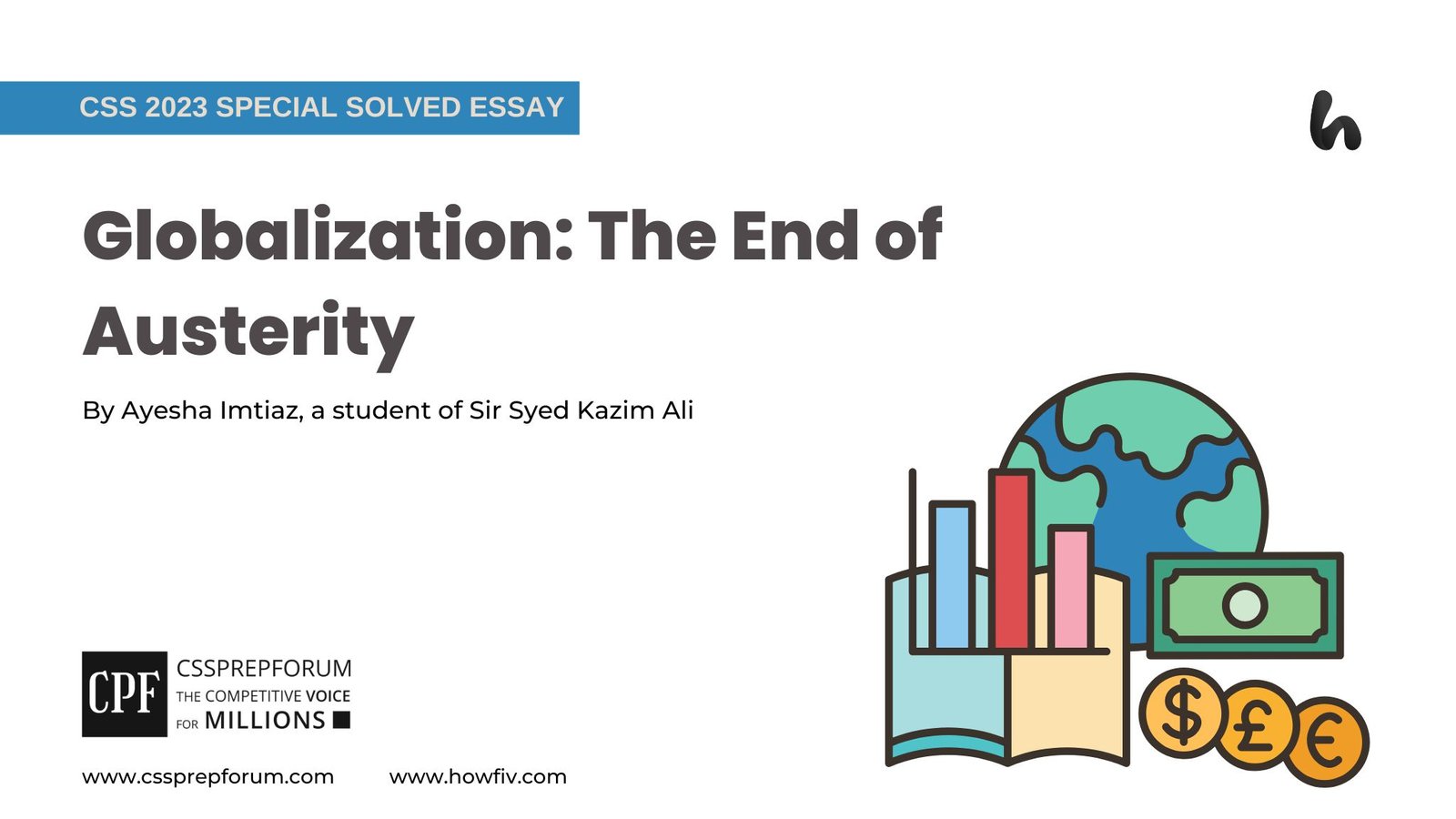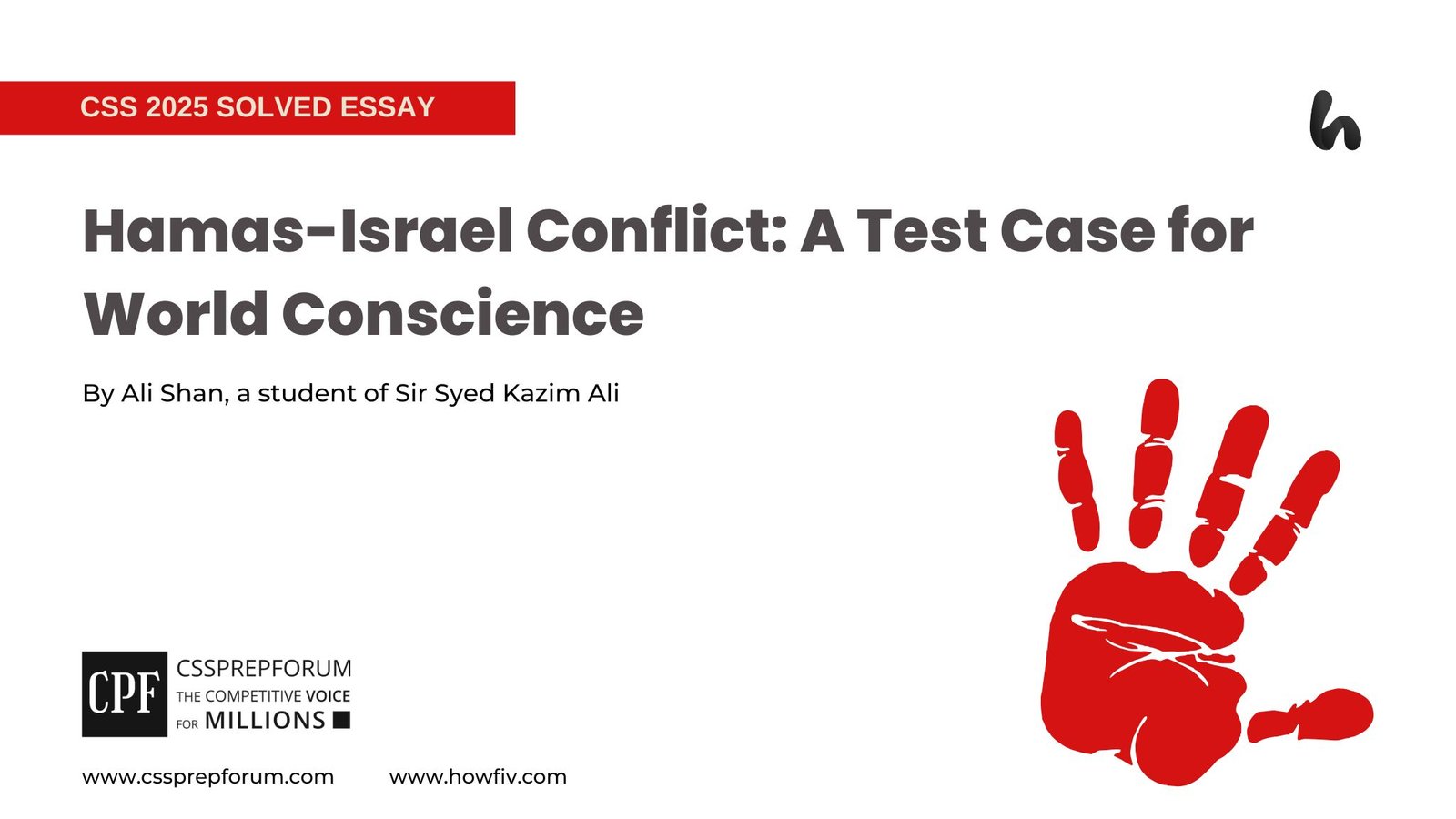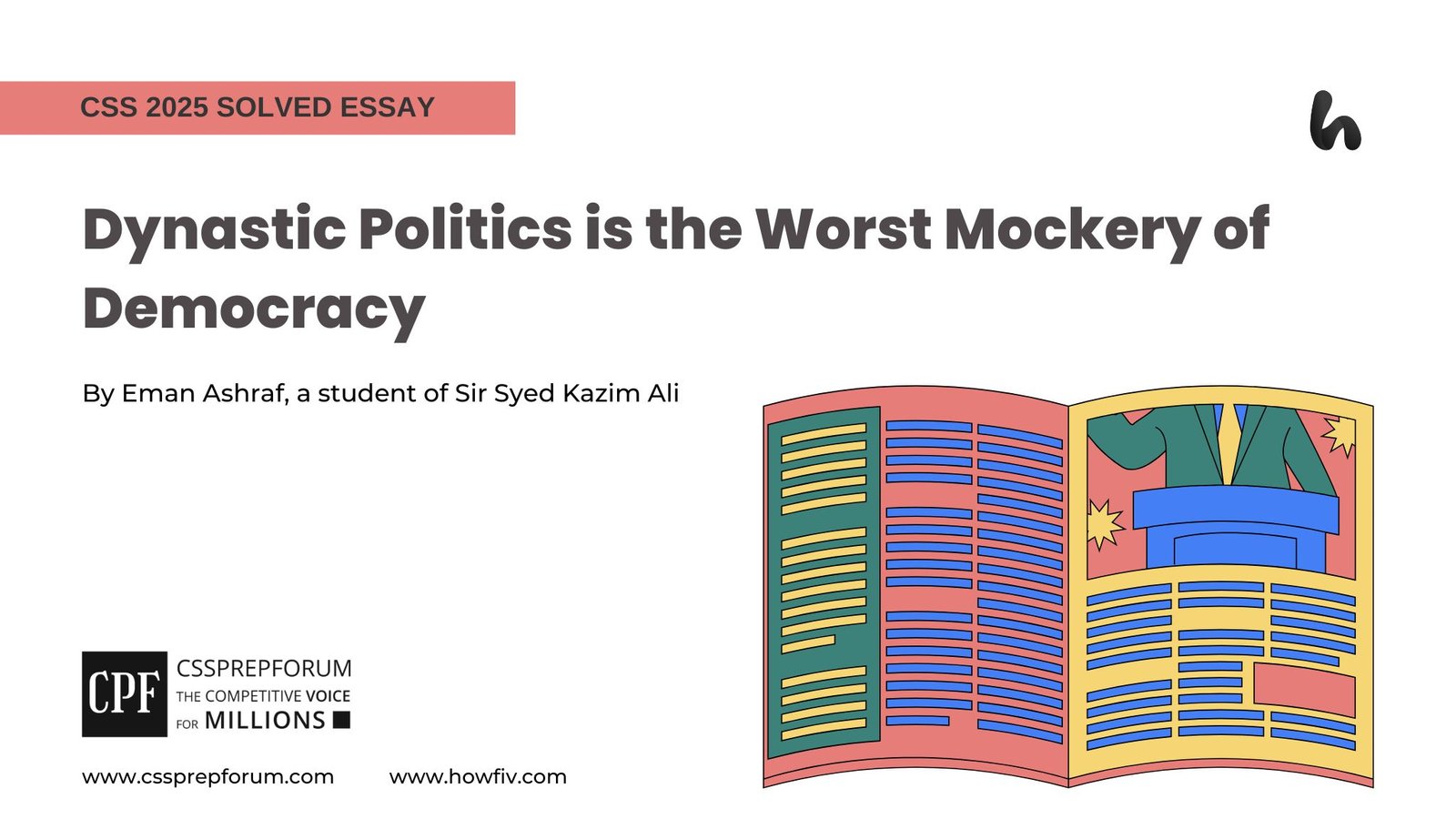Industrial Reforms for Country’s Sustainable Growth | Daily Writeup | Opinions
The following article, “How do Industrial Reforms contribute to a Country’s Sustainable Growth?“, is written by Ayesha Irfan, a student of Sir Syed Kazim Ali. Moreover, the article is written on the same pattern, taught by Sir to his students, scoring the highest marks in compulsory subjects for years. Sir Kazim has uploaded his students’ solved past paper questions so other thousands of aspirants can understand how to crack a topic or question, how to write relevantly, what coherence is, and how to include and connect ideas, opinions, and suggestions to score the maximum.

Industrial amelioration is a bedrock for a country’s sovereignty, political might, and socio-economic sustainability. Undoubtedly, countries worldwide experience stable socio-economic indicators and unrivalled development with a strong industrial foundation. Consequently, the fastest-growing industries are ruling the world’s market. Therefore, industrial reforms promote economic stability, strengthen the government’s regulatory framework, reduce poverty, encourage entrepreneurship and innovation, and encourage international trade and exports of a country. For instance, South Korea, which once struggled to be heard internally, has successfully challenged the world’s industries simply by having a stable and inclusive industrial setup. However, it has been demonstrated that countries with declining industries always lag socially, politically, and, more importantly, economically. Ironically, Pakistan has been included among the states that have done little to stabilize its economic and socio-political affairs due to industrial pitfalls. As a result, the economic crisis has undoubtedly shackled the entire country, forcing it to dance to the tune of the crisis, overshadowing and, for sure, overpowering all other concerns Pakistan faces today like economic doldrums, social imbalance, poverty, and inflation. However, the government can tackle these issues by strengthening the country’s industries. The article delves into how industrial reforms contribute to a country’s sustainable growth. It also sheds light on how industrial decline affects a country’s sustainable growth and how the government should reform it.

Before delving into the primary subject, it is imperative to comprehend the connection between industrial reforms and sustainable growth. Therefore, sustainable development involves all educational, political, and social systems worldwide to create a more sustainable future. In brief, industrial reforms refer to means rather than ends in the long run when it pertains to the sustainability of a country. However, industrial regulation can be viewed as a critical component of recovery strategies within the economically underdeveloped and developing countries, refocusing attention on public action and government intervention. An integral part of all solutions to the acute economic and social problems resulting from abnormally high rates of poverty, deprivation, and unemployment should be industrial policy, as in the case of Pakistan currently, where political instability and economic declivity influence production dynamics significantly.
On the flip side, sustainable growth is regarded as national output growth that adheres to current demands without jeopardizing the capacity of future generations to satisfy their needs. The growing interest in the circular economy is at the heart of the sustainable growth debate. However, the critical components of sustainable growth include advancements in human well-being, cultural preservation, and social and economic development. Additionally, it keeps natural resources from being lost. Moreover, it provides strategies to assist the next generation in realizing its objectives.
Moving ahead, the question of how industrial reforms support a nation’s sustainable growth emerges here. The response to the query is that industrial reforms help a nation’s economy to remain stable. Some possible advantages of industrialization include increased economic growth, tax revenues, and job creation. According to the World Economic Forum’s Global Competitiveness Report, Germany is regarded as the global leader in industrial production and is well-known for its technological advancements, especially in the automotive, engineering, and chemical industries. Ironically, Pakistan’s policies have largely neglected the manufacturing sector in favour of the primary and tertiary sectors.
Furthermore, industrial reforms can significantly improve a government’s regulatory framework by introducing new laws, policies, and regulations that support accountability, efficiency, and transparency in the industrial sector. According to the United Nations Industrial Development Organization (UNIDO), 68% of China’s political regulatory framework has improved due to its industrial reforms. Thus, by ensuring fair competition, protecting consumer rights, and promoting sustainable economic growth, these reforms can aid in streamlining administrative processes.
Moreover, industrial reforms can result in a country’s economic growth that consequently lowers its poverty rate. Industrial reforms can draw investment, encourage innovation, and boost the competitiveness of regional industries by fostering a favourable business climate. Better working conditions, more job opportunities, and higher employee wages may follow from this matter. The new World Bank report, “Bangladesh Development Update October 2023, New Frontiers in Poverty Reduction,” states that the continuous industrial reform-driven economic growth improved living standards to 9.0 per cent in 2020. Therefore, by reducing poverty, industrial reforms raise social standards.
Aside from these, industries are vital to a country’s sovereignty because they contribute to economic stability by building a strong industrial base, which in turn, lessens reliance on foreign loans and aid and, ultimately, makes a country less vulnerable to external shocks. Second, the defence, aerospace and technology industries improve a country’s security and sovereignty. Third, by guaranteeing a country’s self-sufficiency in vital resources, industries linked to energy, agriculture, and natural resources support national sovereignty. Industry in South Korea accounted for 32.4% of GDP and employed 25% of the workforce in 2022 (World Bank, 2023).
Nevertheless, a country can maintain its leadership position in technological advancements by focusing on its industries on research, development, and innovation. This improves a country’s sustainability by promoting competitiveness, stimulating economic growth, and preserving a strong position in international markets. According to the Singapore Economic Development Board (EDB), SPRING is a Ministry of Trade and Industry agency that assists Singapore enterprises in growing and building trust in Singapore products and services. Thus, technological advancement boosts a country’s sustainability and growth.
Last but not least, export-oriented industries are often referred to as those that support a nation’s exports and foster international trade. To increase their reach, these industries actively participate in exporting and concentrate on creating goods and services that are in demand in global markets. According to the World Bank, exports from Hong Kong, Singapore, and South Korea have increased due to industrial reforms. Unfortunately, Pakistan lags in the battle of sustainability.
The antithesis of the above stance is how industry decline affects sustainable growth. First, economic output decreases due to industrial decline, which can be brought on by several variables, including international competition, shifting consumer preferences, and technological advancements. This is because the industrial sector makes a substantial contribution to the economy as a whole, and its decline may have a knock-on effect on other economic sectors. According to the World Bank Report, the economy of Pakistan was hit by a 10.26% overall decline in large-scale industry in FY23. Consequently, the decline in the industry has led to a severe decline in economic output.
Second, the extinguishing fire was fueled by a decline in the industrial sectors overall productivity and competitiveness. Several reasons for this decline include the reduction in research and development (R&D) activities. Industries that cut back on R&D may see a decline in innovation, a halt to technological breakthroughs, and eventually a drop in productivity. According to Nadeem F. Paracha, industrial decline can hurt R&D activities in any country, including Pakistan. Therefore, industrial decline led a nation into a vicious cycle of stagnation.
Third, the decline of industry can enormously impact society and cause social hindrances. Nonetheless, a decline in an industry frequently leads to job losses and unemployment, which can harm people’s lives and communities. As an illustration, consider the UNDP’s report on how Pakistan’s declining industries have widened the divide between the rich and the poor. Therefore, this demonstrates how social obstacles directly result from the industrial decline.
Fourth, poverty is made worse by industrial decline in several ways. In the impacted areas, industry closures may result in job losses and unemployment. Thus, a decrease in income levels and an increase in the number of people living in poverty may follow this loss of work opportunities. Likewise, industrial decline has a ripple effect on the local economy. Tax revenue declines as a result of business closures, and this can have an impact on public services like infrastructure, healthcare, and education. This makes the area’s poverty situation even worse. For instance, the World Bank’s World Development Indicators data set estimates that Pakistan’s poverty incidence increased by 39.80% in 2018 due to industry declines.
Finally, a country’s sovereignty may be compromised due to increased loans and debts brought on by an industrial downturn. This downturn leads to decreased productivity and economic output, which lowers tax collections. A country may be forced to borrow money to pay for development projects or cover its expenses due to this decline in revenue. A country’s sovereignty may be jeopardized if it takes on more debt and loans and depends more on foreign lenders. The World Bank reports that Pakistan’s external debt increased from 125.8 USD billion to 124.3 USD billion in June 2023, mainly due to the country’s declining industrial output. Thus, it proves that a country’s industrial decline causes it to decline into economic stagnation and unsustainability.
As every problem has a solution, some actions also additionally reinforce industries. First and foremost, the nation must invest in economic diversification and infrastructure. A nation can increase productivity, draw in foreign investment, and generate job opportunities by investing in infrastructure, such as energy systems, transportation networks, and communication technology. Second, economic diversification entails encouraging the expansion of several industries while minimizing dependence on a single industry or sector. This promotes competitiveness, reduces risk, and promotes long-term economic growth. Encourage public-private partnerships, as it has been demonstrated, are the icing on the cake. Nevertheless, promoting public-private partnerships for industrial growth means that the public and private sectors work together to advance economic growth and job creation. This may entail pooling workforce development, infrastructure, and research and development resources. Lastly, it is imperative to promote special economic zones. These zones seek to promote exports, foster a business-friendly atmosphere, and draw in both foreign and domestic capital. SEZs have proven effective in some nations, including China, India, Singapore, and several African countries.
In a nutshell, a nation’s ability to succeed economically, socially, politically, and technologically depends on its industrial reforms. As a result, industrial amelioration is essential to a nation’s political power, socio-economic sustainability, and sovereignty. Unquestionably, nations with a solid industrial base see stable socio-economic indicators and unparalleled development worldwide. Nevertheless, the collapse of industry causes a downturn in the economy, obstacles in society and politics, destruction of technology, increased poverty, and unsustainability. However, the government can address these problems by promoting special economic zones, encouraging public-private partnerships, and investing in infrastructure and economic diversification.

CSS Solved Past Papers’ Essays
Looking for the last ten years of CSS and PMS Solved Essays and want to know how Sir Kazim’s students write and score the highest marks in the essays’ papers? Then, click on the CSS Solved Essays to start reading them.
CSS Solved Essays
CSS Solved General Science & Ability Past Papers
Want to read the last ten years’ General Science & Ability Solved Past Papers to learn how to attempt them and to score high? Let’s click on the link below to read them all freely. All past papers have been solved by Miss Iqra Ali & Dr Nishat Baloch, Pakistan’s top CSS GSA coach having the highest score of their students. General Science & Ability Solved Past Papers











